Image Security
Image Backup In The FieldI once met a guy on a photo trip. As is normal, we introduced ourselves. One of the early subjects that came up was our employment.
He said that he was a security guard in a large corporation. He did not sound or look particularly happy about his job.
I looked at him for a moment then said,
"That's a tough job. No one cares about you or notices you until something goes wrong".
He looked at me in surprise then I could see something like relief on his face. He realised that I understood. The job was difficult because it was stressful working with the unknown, the "maybe today, maybe tomorrow, maybe never" horror that's the norm with security work.
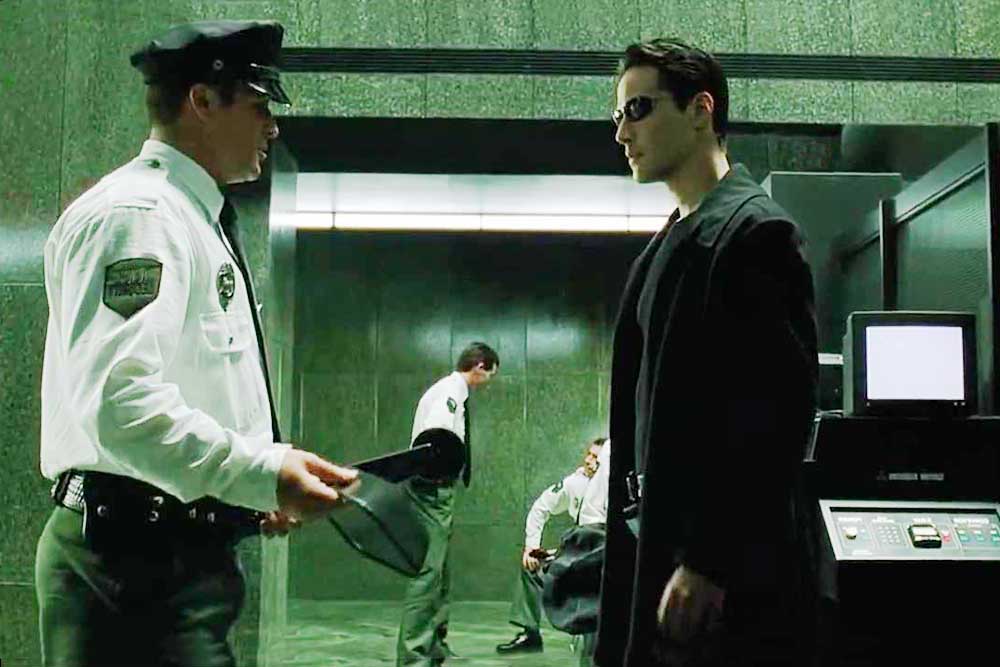
What could possibly go wrong.....
When we head out into the unknown, we might have zero issues. Everything works. No problems arise. All is good.
Other times a small thing can go awry. We lose our sunglasses, a strap breaks on our snowshoes, the camera batteries die. We put up with it and get by, maybe with backup batteries or a couple of nut bars if we get hungry or we peel off some gaffer tape from our tripod and fix that broken strap.
But when it really hits the fan, that's when we need our security guard. That's when we really need our "probably never happen" contingency plan to work flawlessly.
The worst thing that can happen to us is to die in the field. Scratch that. If I die in the field, make sure you save my memory card. That's the most important thing for me. A gold medal image of a wolverine tearing open a bison carcass is worth nothing if you then lose the image file.
Yes, we can drop a memory card in the snow or in a river, but usually the way we lose images is by accidentally deleting them. Oh the angst from formatting a card only to find, hours or days or weeks later, that we forgot to back them up first.
We can also have a card become corrupt, although that's rare. It happens, but not often. Plus, there's some serious software options out there that you can buy to recover data from a damaged disc.
But the risk is real. When you're on an extended trip, from a five star luxury safari in Africa to a low budget "hike out into nowhere" trip, you can make mistakes with your image files. It's been a long day, you're a few days into the trip and fatigue is starting to set in. All you want to do is eat then go to bed. You're suffering from mild brain fog, you're a bit irritated, you have stuff to do to be prepared for the next day.
Mistakes can, and do, happen.
Imagine if you paid $20,000 for air fares, travel, guides and accommodation then travelled for 3-4 days to get to upper Mongolia to photograph snow leopards. After a week you manage to find one snow leopard then, miracle of miracles, you get a reasonably close, tack sharp, perfectly framed sequence of it taking down a Siberian Ibex. National Geographic is going to be knocking on your door.
But because you're still jet lagged, are suffering from altitude sickness from the 5000m elevation, are wiped out from hiking up near vertical scree covered slopes, sleep deprived from being baked on one side by the yurt's yak manure stove and frozen on the other by the icy tent wall, you make a mistake with your backup and then format your card, or accidently put it back into the camera and overwrite it with stupid selfies.
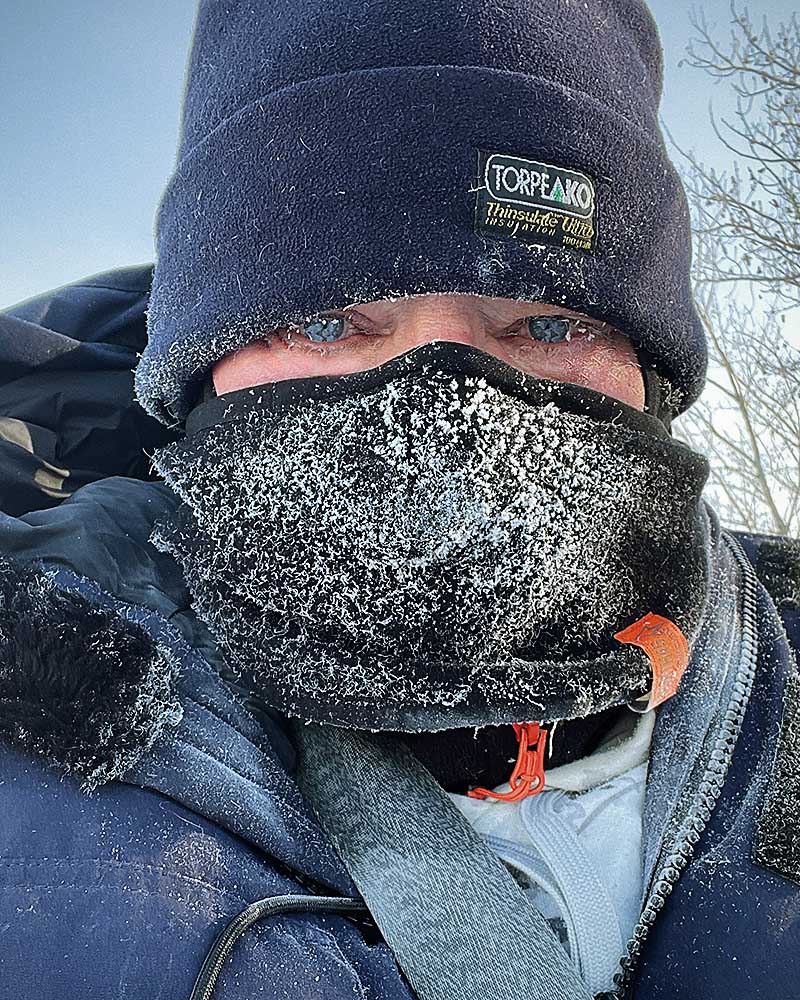
And this one is of a snow leopard with...... oh, dammit....
Don't scoff. It happens. I know a photographer who was one of the first to ever photograph rare Antarctic wildlife over a number of weeks, including species never before recorded on camera. He was down there for a couple of months working with researchers.
When he got back to the mainland, they all went out to dinner. When they got back to their hotel, they had been robbed, probably by a staff member. He never saw his shots again. What's worse, the thief probably threw them away.
Making mistakes is a near certainty. You need a security guard for your images.
The first thing you need to do, at the end of every day, is to backup your files from that day.
Don't laugh. A lot of people don't do this basic step. Their backup method is to put in a new memory card and wait until they get home to download everything. Sure beats waiting for that slow download to finish before you eat or go to sleep.
The problem with that is you haven't backed anything up. You just end up with a bunch of memory cards, each holding the original image files. There is no backup. No copies.
You can lose a card easily. They're small, cost a lot and hold your precious images. Of course they're going to get lost or written over or dropped down a pit toilet or fried by a microwave. It's Murphy's law.
So let's look at a basic backup setup that's easy to use.
The best system is to have AT LEAST two copies of every image you shoot. Three is better, four better still, but two is a good starting point.

At least two - that's a good starting point
Note: This is not the system I suggest for all your master files back home or in your office. This is a system for backing up in the field.
You basic setup is a laptop, a card reader and two hard drives. This will ensure that you have at least two exact copies of every image you take on a trip.
If you have lots of memory cards you can also switch cards and keep the originals as well, but you must also have your two backups. Minimum.
The list would look like this:
- Laptop with charger.
- At least one card reader (Two is better. They do fail).
- Two hard drives.
- Two cables for those two drives.
Not one cable, two cables. You may only need to use one cable at a time but cables fail and/or get damaged. So two cables. You may also need to have both a card reader and backup drive connected at the same time, so make sure you have enough cables, including a spare.
Also, any adaptors that you may need for those cables to make the backup system works with your laptop.
The process would be:
Turn on your computer. Make a folder on your laptop (or your first backup drive) with a unique label. I use the day's date plus a short description, such as: 2024_01_15_Wolverine_Finland.
If you start your label with the reverse date (year, month, day) the folders will always sort chronologically making it easier to keep track of things. Plus it avoids that American month/day/year illogical insanity.
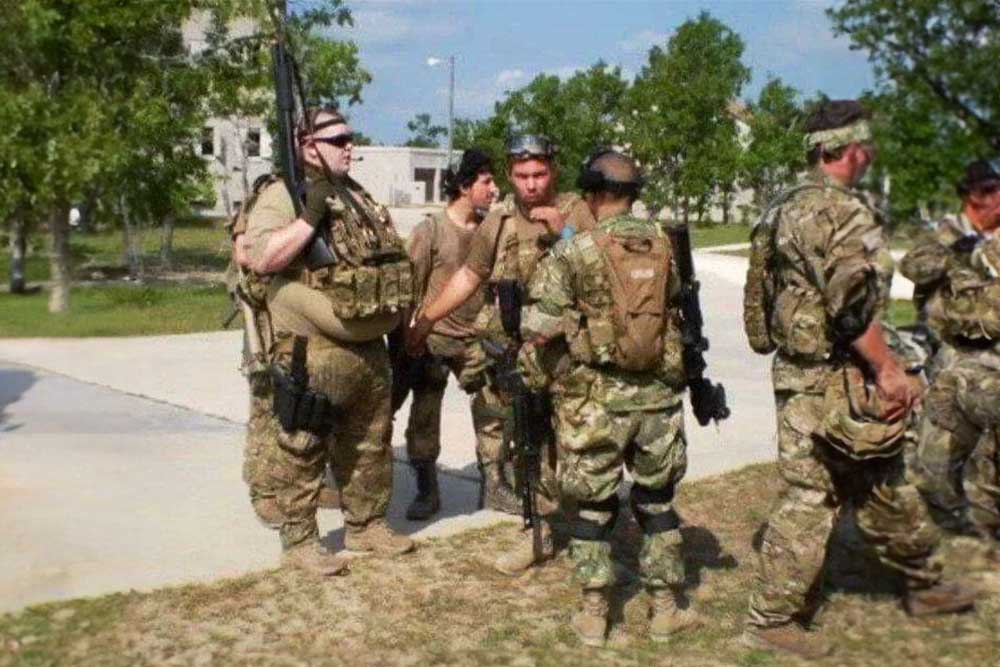
Fortunately, an illogical date format is the only thing that the US gets wrong....
Insert the memory card. Copy the files into that folder on your laptop's hard drive. I copy just the image files but you're welcome to copy everything that's in your card's root folder (everything shown when you first open the card's icon on your desktop).
When that's completed, plug in your first hard drive.
Copy that folder, from your laptop, containing the day's images onto your backup drive.
You might want to skip copying to your laptop's hard drive, possibly because of a lack of space, and just use the laptop's hardware to transfer images directly from the card reader to the backup drive.
Note: If you're backing up multiple cards from one or more cameras, you might run into the issue of having duplicate folder names, if you're copying the folders from your card and not just the raw image files. The solution is to create multiple sub folders in your main/original folder. Name them anything you want, like camera1 or camera2 or even "morning" and "afternoon". Whatever works for you, it's not that important. Just make sure that all of your days images get backed up into that single folder.
If you can, leave a copy on your laptop's hard drive as well. It's a good additional 3rd backup plus you have all your images there in case you want to work on them on a plane or wherever. No need for a hard drive dangling off your laptop.
When that transfer is complete, plug in your second drive and copy the day's folder to that second drive as well.
Now you have at least two backups, three if you have copies on your laptop's hard drive and four if you don't reuse the card.
If you are going to reuse the card, place it back into your camera (after the initial backup, of course) and format it using the camera's format menu item.
Don't delete files on your card using your computer. Reformatting not only deletes the files, it refreshes the memory card's software system for storing images, removing any corrupted file(s) in the process. You will have fewer card errors if you format "in camera".
An additional bit of security is to physically store your backups seperately. Keep one of the hard drives in your backpack or, if you are in a camp or hotel, with someone else such as another photographer in a different room or a staff member who stays in the base camp. In other words, don't keep them all in one place. And, of course, if you're staying in a hotel, use the room safe.
Remember, we're trying to prevent a "worse case scenario". Does your tent burn down? Does the hotel get demolished in an earthquake? Are your bags stolen at the airport? Does someone steal your car?

Amelda never did like the photographer next dooor....
Splitting your backups, physically keeping them apart, will at least allow you to keep your images, even if everything else you own is gone.
Hard Drives
What sort of hard drives should you use?
Obviously, drives that are not powered from a wall socket are required for off-grid use. External portable drives are what you need.
The drives I use are SanDisk Extreme Portable 2TB or 4TB Solid State Drives (SSD). They are very small, compact, slim, USB-C connected, rugged drives that never quit.
Up until recently I used two 1TB drives but shooting video is making them feel cramped. A recent polar bear trip had me fill 1TB in two days.
I'm not pushing SanDisk here. That's just what I curerently use. I also have Crucial and Seagate drives, but they don't fit the hollows in my foam inserts, so I guess my choices are dictated on how lazy I am.
Recently, a newer version of the SanDisk drives were released (Gen 2 or second generation). They had major issues on Mac computers. A recent software update on the drives seems to have fixed that problem. Older versions did not have that issue.
This highlights the fact that you shouldn't buy something new the day before you leave for a trip and expect it to work. Or use an expensive expedition to try out new techniques or camera settings or a new camera body/lens. Go with what you know.
There are cheaper "no name" drives that you can get on eBay or Amazon or Alibaba. But you're looking for bulletproof backups. Don't risk it with cheap drives that can randomly quit. It's happened to me. Be warned.
If you really need to watch every gram, such as when backpacking, you can bring along a few 512gb, or even 1tb, mini/microSD cards with a suitable card reader. They're VERY cheap, about the size of a small fingernail and weigh nothing. Yes, they're slow, but it's an option. See below for "no computer" backups and make sure you abide by the "test it first" principle above.
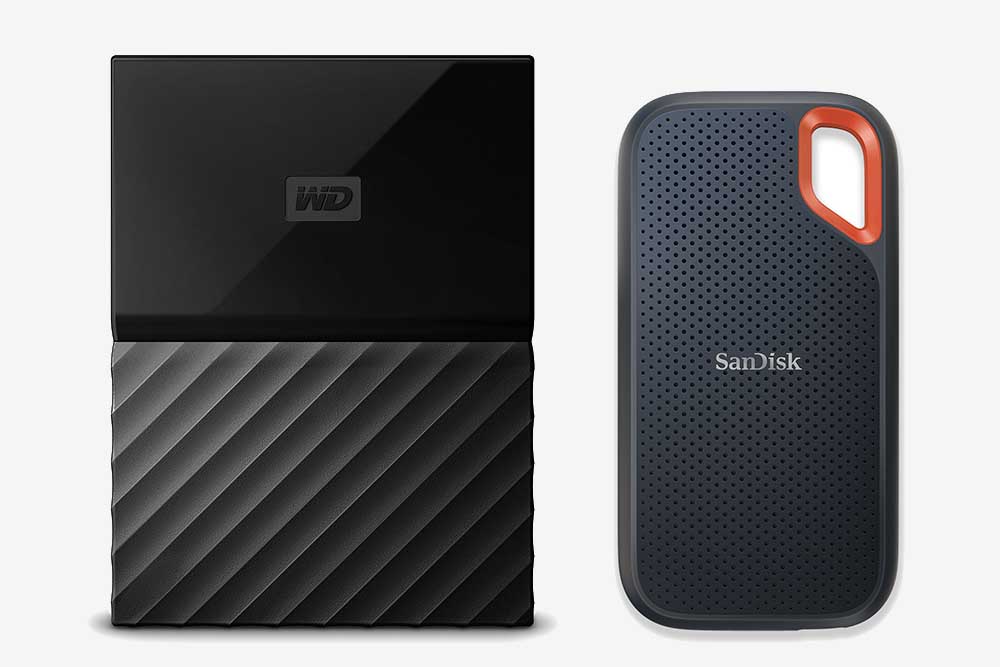
"Normal" & solid state (SSD) style hard drives. Size and weight are significantly different
Which brings me to a guiding principle that should rule your photographic life:
Only use tried and tested gear and techniques on an expedition.
What sort of laptop?
It doesn't matter, just as long as it has the connection ports for your hard drives and a working charger. As mentioned above, having adequate empty disc space helps as well, but isn't vital if you don't need/want a backup on your laptop.
Of course, your hard drives should be formatted to work with your laptop AND your desktop back home. If you need a bulletproof cross platform format, use exFat. Google how to format your hard drives and test them with your backup and office system.
Card Reader
As mentioned, even the best fail, some sooner than later. A second reader will fix that potential problem. Better to have it and not need it, etc.
If you're buying one now, make sure it's USB-C compatible. That will help future proof it and avoid the need for an adaptor down the road.
Of course, if you're using multiple types of memory card (CF, SD, cfExpress, etc) then be sure to pack the appropriate readers.
Backups With No Computer
I have done trips where weight is a premium factor, namely backpacking and sled camping in the snow. Leaving your laptop behind, along with powerbanks to charge it, is a serious temptation. In fact, it's what I do on those types of trips.
So how do you backup to external hard drives without a computer?
You use your phone.
Chances are, even if you're in a remote area with no coverage, you'll still have your phone with you. I use mine for it's offline Google maps with GPS or navigation apps or just to use it as a notepad and backup video/camera for visual notes.
If you switch out your laptop with a phone, you save at least a kilo in weight, sometimes more.
The kit I use has a couple of small dongles and some extra cables, but it packs up small and very light, enabling me to copy from a card to a hard drive via a powered hub and a smart phone.
Here's a diagram showing how it connects together:
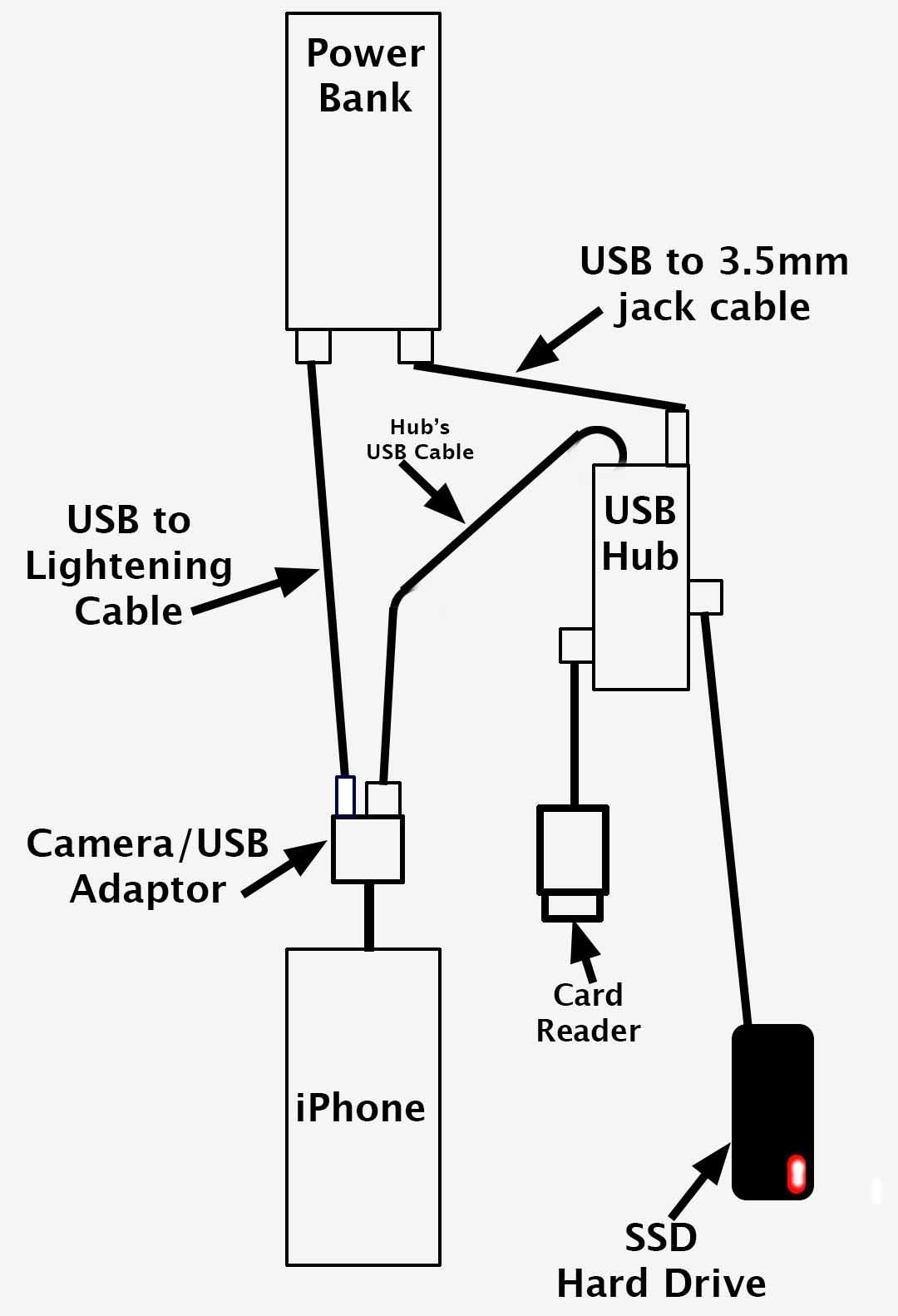
Look ma, no computer!!!
Since you're most probably already bringing your phone and a powerbank, plus the card reader and backup drive, the only additional items you need are the powered hub, the camera/usb adaptor and a couple of cables. Much smaller and lighter than a laptop.
Notes about the parts shown above:
While you can use any powerbank, I suggest that you use a PD or Power Delivery rated powerbank as that will enable you to use it to recharge your phone and even, with a USB-C connecting cable, your camera. But for basic card to hard drive backups, any USB-A powerbank will do the job.
This system works, BUT it's slow. I suggest you test it before you go out into the boondocks (see note above). If you're going to be shooting thousands of stills (obviously in raw format or comnpressed raw) and/or video every day, this may not be suitable. You might just have to bite the bullet and accept the weight and bulk of a laptop system.
The Camera/USB adaptor is necessary to connect to an external powered USB hub. The USB hub also needs to be powered to have enough "oomph" to transfer the data. The powerbank is there to power both the USB hub and the camera/USB adaptor (an iPhone accessory).
My apologies to Android users. You can still do it, you just need to replace the camera/power adaptor with whatever Android uses. Everything else, except for the iPhone, is as it should be. A quick Google search will have you find a YouTube video that will sort that out.
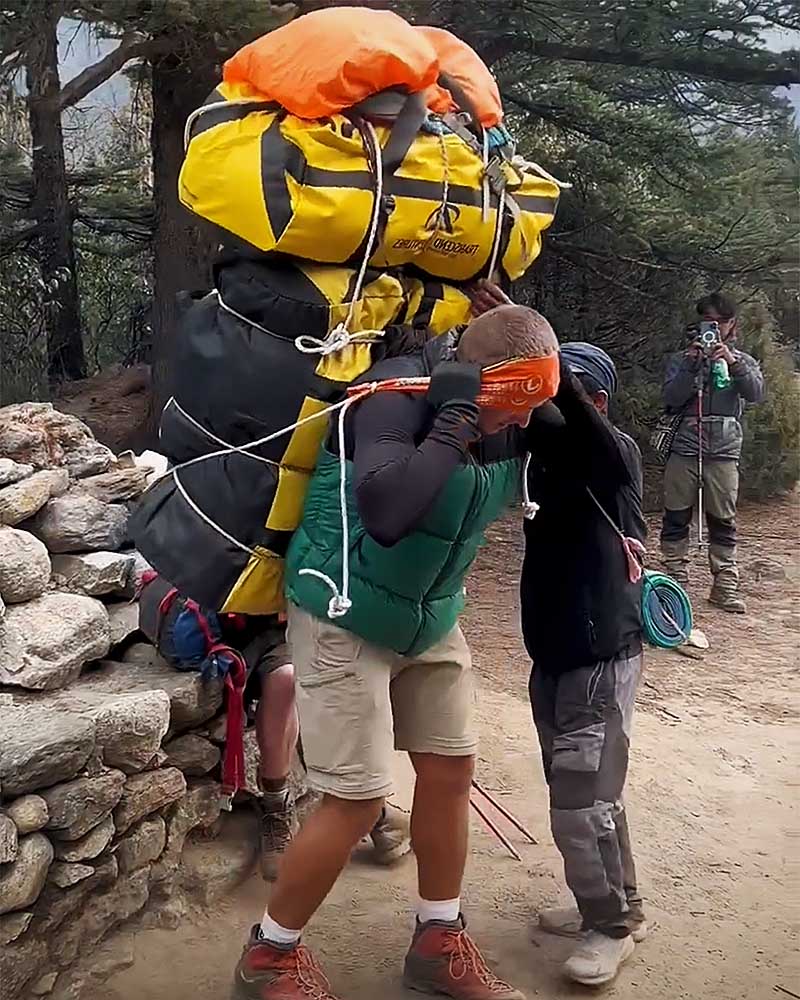
Mebbe leave the laptop at home
At Home
Once you're back home, you need to do it all again. Fortunately now you have the option for the MUCH cheaper external (or internal) hard drives that connect to household power. You can buy a 10-20TB drive for about the same as a portable 1TB SSD drive. If you shoot a lot of video, or are paranoid about hard drives failing, you should consider a RAID system. Google is your friend here.
The principle here is to have AT LEAST TWO copies of your image files. Three or more is even better.
Once I have edited my images, I backup all of my "keepers" to at least two seperate hard drives. In practice, it's three drives.
All of the images and video that I have not used (after I have deleted all total failures, such as badly out of focus pics or frames of my foot or the sky from an accidental shutter triggering) are stored on a single hard drive. I'm not that fussed about losing the rejected images. Sometimes I do go back to pick out a different frame from a squence, but otherwise they're expendable.
Some photographers I know backup absolutely everything that was shot on a trip. Everything, warts and all. I'm a little less fussy about that; it's the "keepers" that are important to me.
The principle here is to have AT LEAST TWO copies of your "keeper" image files. Three or more is even better.
Once you've copied everything across to your home system, you can go ahead and format the backup hard drives you used in the field, although I usually leave them as they are until I'm on my next trip, just in case.
The Bottom Line:
Everything you shoot while out in the field should be backed up at least once a day to at least two backup drives, having three or more copies is even better.
Don't be distracted when backing up. Focus and get it right.

Don't lose your shots - back it up!!
